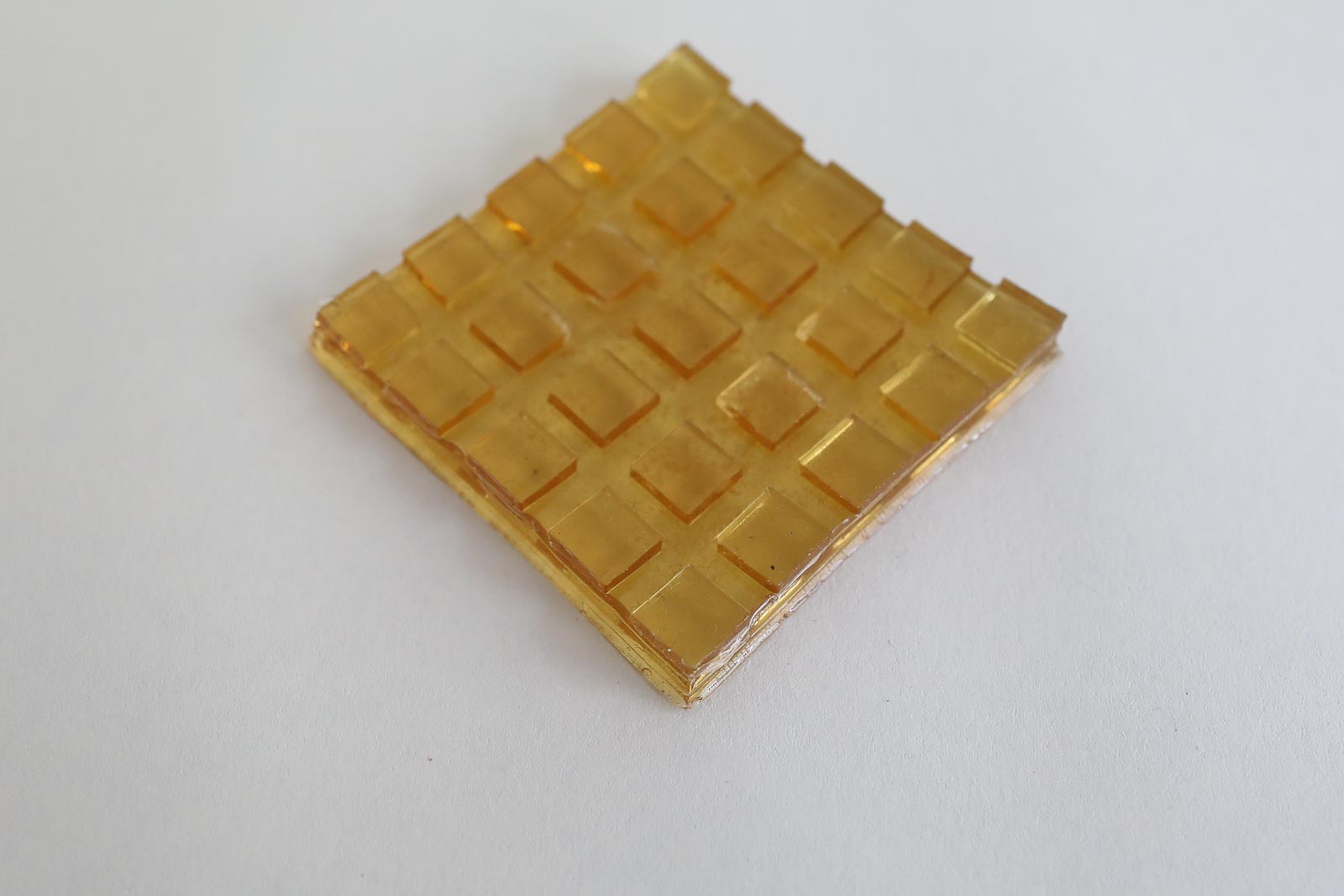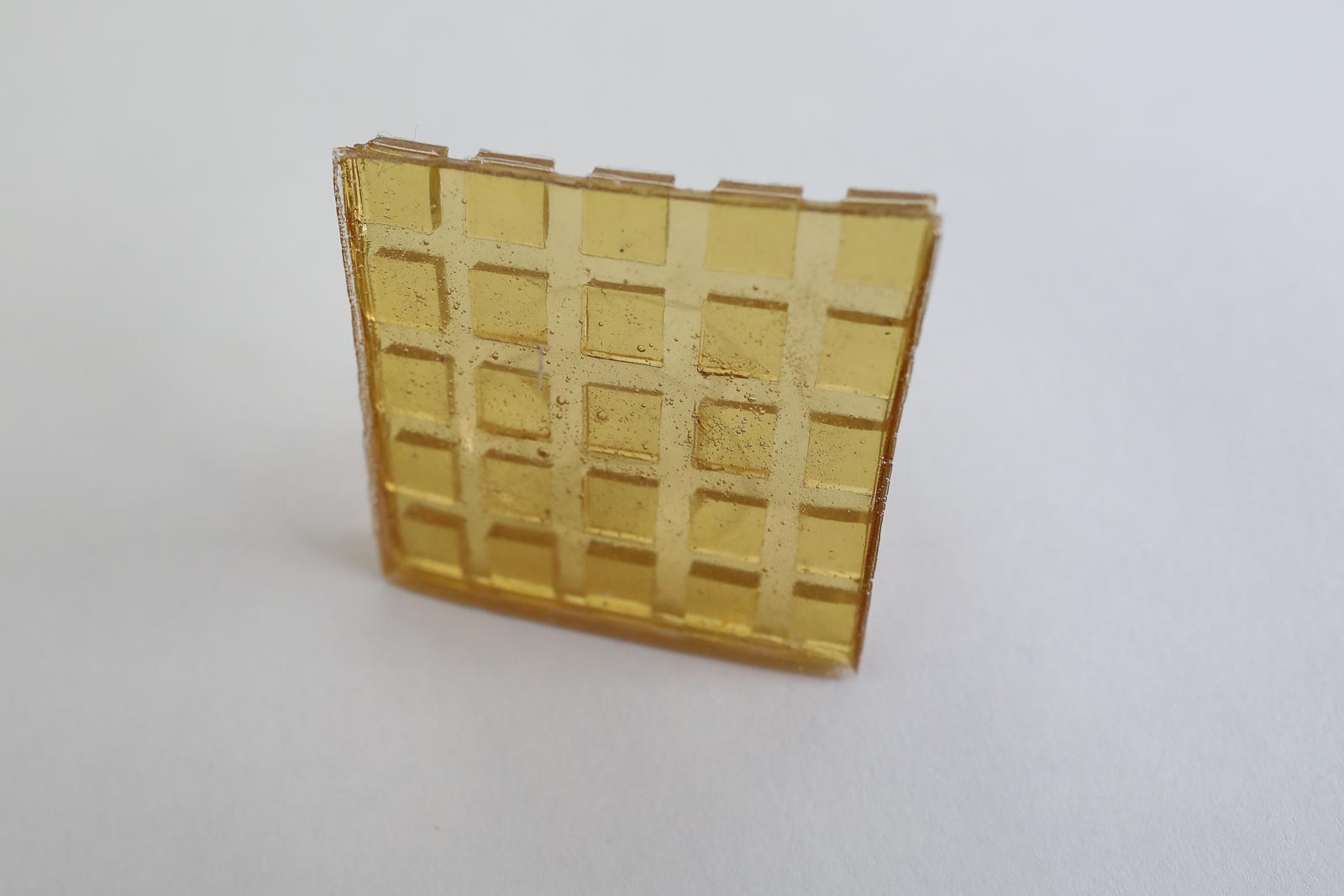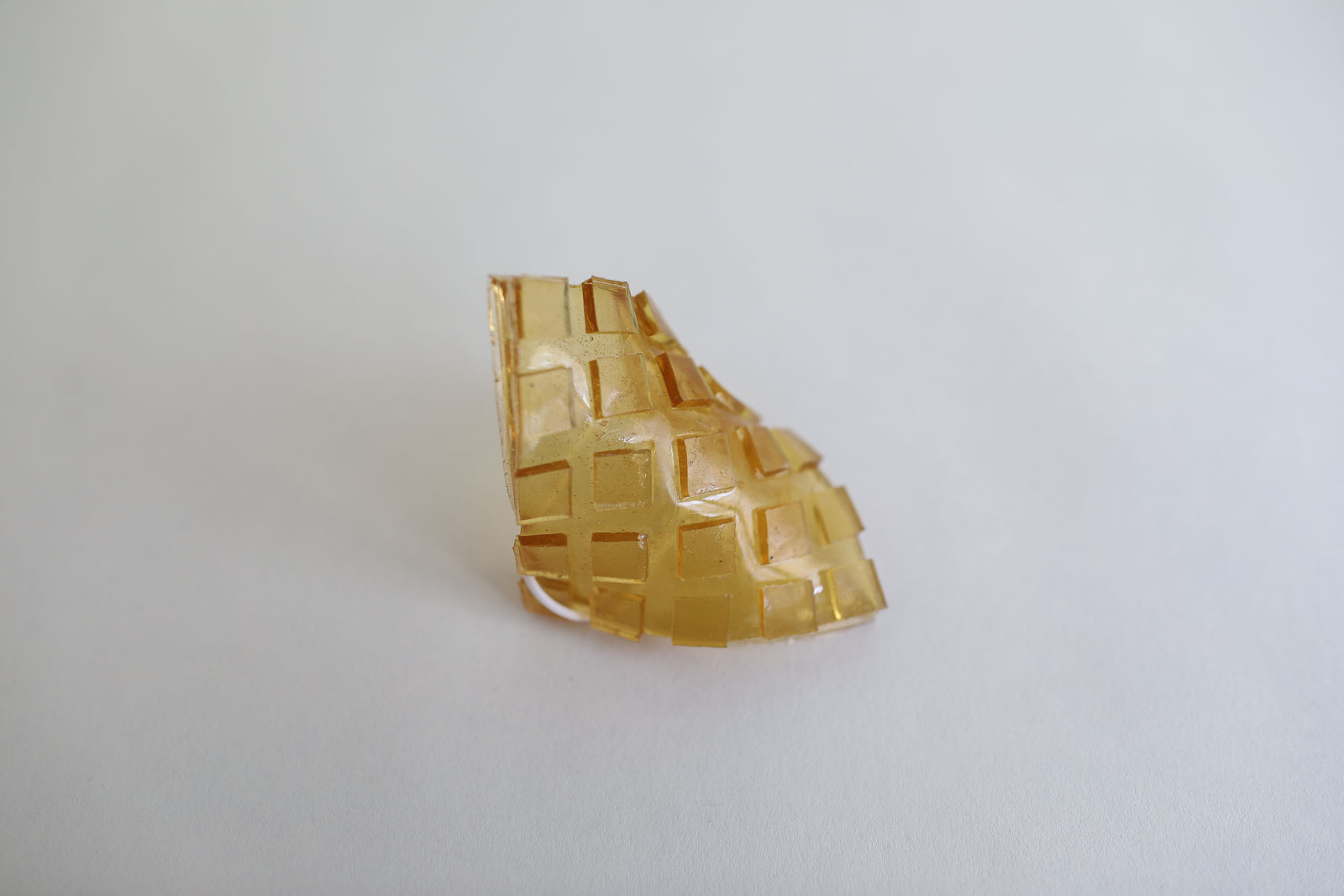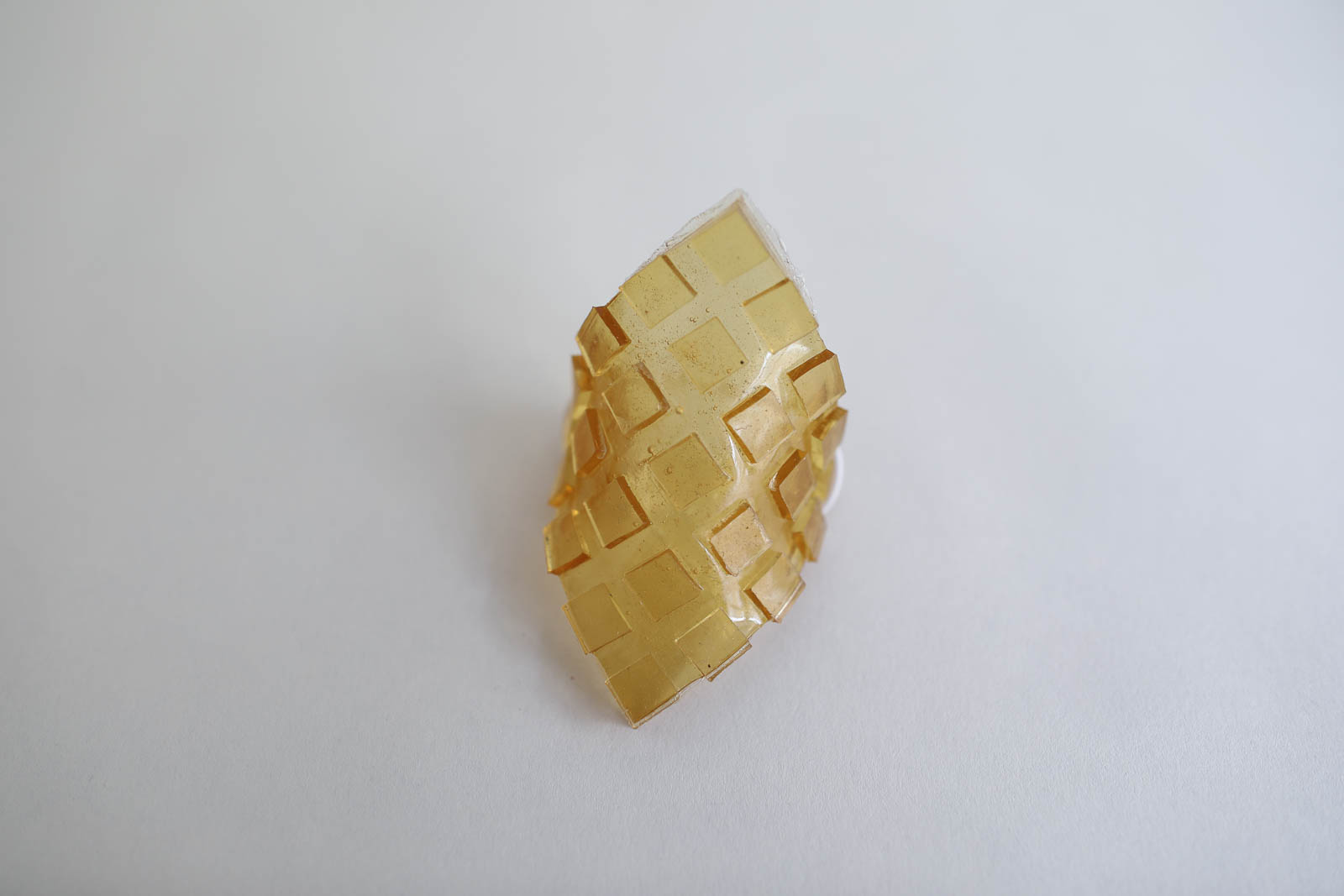- BIOSILICONE
- Tactility & sound impression
- Description
- Physical form
- Fabrication time
- Ingredients
- Tools
- Yield before processing/drying/curing
- Method
- Drying/curing/growth process
- Process
- Variations on this recipe
- Cultural origins of this recipe
- References this recipe draws from
- Known concerns and contestations*
- Sustainability tags
- Material properties
- Comparative qualities
- Technical and sensory properties
- About this entry
- Maker(s) of this sample
- Environmental conditions
- Recipe validation
- Estimated cost (consumables) in local currency
- Local supplier/sourcing info
- Copyright information
- This recipe is in the public domain (CC0)
- This recipe was previously published by someone else
- Images of final product
BIOSILICONE
Tactility & sound impression
Description
A (naturally) yellow, flexible biosilicone, gelatin-based.
Physical form
Solids
Color without additives: transparent, yellow
Fabrication time
Preparation time: 1 Hour
Processing time: 5-10 days
Need attention: every 12 hours, alternate pressing and drying, (press overnight, let dry through the day for example, or leave to dry on a roster). Leave it to dry as long as is feasible with lots of airflow.
Final form achieved after: 10 days
Ingredients
-
Gelatine powder - 48 gr
- Functions as the polymeer (so it becomes a solid)
-
Glycerine - 48 gr
- Functions as plasticizer that bonds with the gelatine (makes it flexible).
-
Water - 240 ml/gr
- To dissolve and mix the polymeer and plasticizer
Tools
- Cooker or stove (optional: temperature controlled)
- Pot
- Scale
- Moulds (I use a modular mold from laser cut 3 mm acrylic sheets here that are held together with screws)
- Spoon
Yield before processing/drying/curing
Approx. 250 ml (make sure to evaporate enough water during cooking time)
Method
-
Preparation
- Weigh your ingredients
- Prepare the mold and find a place where you can leave it for a while, ideally near an open window where there's air flow.
-
Mixing and dissolving the ingredients
- bring the water to the boil
- optional: add natural dye if you wish to use color
- add the glycerine
- add the gelatine
- keep the temperature below 80 degrees celcius while stirring very very slowly and gently to avoid making bubbles. I prefer a simple spoon to do this, not a whisk.
-
Cooking the ingredients
- Simmer and slowly stir the mixture between 60-80 degrees celcius for 20-25 minutes, until it's like a syrup.
- Longer cooking time allows more water to evaporate and as a result it will shrink less during drying. Make sure it's still liquid enought to pour.
-
Casting
- Cast into the mould slowly to avoid bubbles
- Pour from the middle and hold still, let the liquid distribute itself.
- Put the mould away to dry in a cool place with lots of air flow (like near an open window). A warmer place might speed up the drying process but also allow bacteria to grow faster and can result in fungal growth.
Drying/curing/growth process
- Mold depth: 3 x 3mm layers
- Shrinkage thickness: 20-30 %
- Shrinkage width/length: 10-20 %
Shrinkage and deformation control
Letting it dry up to ten days to get to the final form. It will be very flexible at first but will slowly harden. Tends to curl up if it is not pressed down during drying (the design of this mold allows for airflow even when pressed). Laying it on a smooth surface helps to keep it flat, it "sucks" onto the surface.
Curing agents and release agents
None.
Minimum wait time before releasing from mold
3 days
Post-processing
Store in a dry and ventilated room.
Further research needed on drying/curing/growth?
Casting larger volumes without growing fungus/mold and deformation would require further experimentation.
Process
![]() preparing the mold, Loes Bogers, 2020
preparing the mold, Loes Bogers, 2020
![]() thick mixture, Loes Bogers, 2020
thick mixture, Loes Bogers, 2020
![]() biosilicone slab just after mold release, Loes Bogers, 2020
biosilicone slab just after mold release, Loes Bogers, 2020
Variations on this recipe
- Add a natural colorant such as a vegetable dye or water-based ink (e.g. hibiscus, beetroot, madder)
- Add less glycerine for a rigid biosilicone
- Stiffeners such as fibres, yarn or natural debris may be added for more structure and reinforcement.
- Fillers such as almond or sunflower oil, can be added to prevent additional shrinkage but might affect stickyness.
Cultural origins of this recipe
Bioplastic production is older than petrol based plastics. In 1500 BC, people in Egypt were already using glues based on gelatin, casein and albumin for furniture constructions. Gelatin casting as a technique has also been used in production of jelly-based foods such as aspic, jelly desserts and candy.
Needs further research? Not sure
References this recipe draws from
- Biosilicone Recipe by Cecilia Raspanti (Textile Lab, Waag), Fabricademy Class "Biofabricating", 2019, link.
Known concerns and contestations*
Needs further research
Gelatin is an animal-based ingredient. Some might find it problematic to use resources that requires killing an animal because of religious or animal welfare beliefs. Arguments are also made that as long as there's a meat industry, it is better to use product from the entire animal, including skin and bones. Some might consider gelatin to be a product that comes from a waste stream, but this is considered controversial by others.
Acrylic (for the mold) is a petrol based plastic but results in very shiny foils and sheets and can be reused endlessly for casting high quality bioplastic sheets.
Using renewable ingredients is not by definition petrol-free. Imagine they have to travel long distances by plane, boat or truck: it takes fuel. Also, the effects of GMO technologies and pesticides can be harmful to the environment and it's worth using knowing the source and production standards involved. If you can afford it, buying organic ingredients is a good starting point.
Sustainability tags
- Renewable ingredients: yes
- Vegan: no
- Made of by-products or waste: no
- Biocompostable final product: yes
- Reuse: yes, by melting and recasting
Needs further research?: not sure
Gelatine-based bioplastics can be recasted by melting them in a pot with some water. Recycling them with PET plastics contaminates the waste stream. Compost bioplastics in a warm environment with sufficient airflow.
Material properties
Comparative qualities
This silicon is rather flexible considering it's thickness, but is quite hard when compared to silicone rubber baking trays for example that often contain softeners. Thinner sheets are more flexbile, thicker less.
Technical and sensory properties
- Strength: strong
- Hardness: flexible
- Transparency: transparent
- Glossiness: glossy
- Weight: medium
- Structure: closed
- Texture: smooth
- Temperature: medium
- Shape memory: high
- Odor: moderate in final form, strong during production
- Stickiness: medium
- Weather resistance: poor
- Acoustic properties: needs further research
- Anti-bacterial: needs further research
- Non-allergenic: needs further research
- Electrical properties: needs further research
- Heat resistance: low
- Water resistance: water resistant
- Chemical resistance: low
- Scratch resistance: high
- Surface friction: braking
- Color modifiers: none
About this entry
Maker(s) of this sample
- Name: Loes Bogers
- Affiliation: Fabricademy student at Waag Textile Lab Amsterdam
- Location: Rotterdam, the Netherlands
- Date: 19-02-2020 – 01-03-2020
Environmental conditions
- Outside temp: 5-11 degrees Celcius
- Room temp: 18 – 22 degrees Celcius
- PH tap water: 7-8
Recipe validation
Has recipe been validated? Yes
By Cecilia Raspanti, Textile Lab, Waag Amsterdam, 9 March 2020
Estimated cost (consumables) in local currency
1,68 Euros for a yield of approx 300 ml
Local supplier/sourcing info
Gelatin powder - Jacob Hooy (online retailers) Glycerine 1.23 - Orphi/Chempropack (online retailers) Molds - acrylic sheet from hardware store or online retailers, lasercut Nuts and bolts - from hardware store
Copyright information
This recipe is in the public domain (CC0)
Yes
This recipe was previously published by someone else
Yes, in: Biosilicone Recipe by Cecilia Raspanti (Textile Lab, Waag), Fabricademy Class "Biofabricating", 2019, link.
##References
- The Secrets of Bioplastic by Clara Davis (Fabtex, IAAC, Fab Lab Barcelona), 2017, link.
- The Bioplastics Cookbook: A Catalogue of Bioplastics Recipes by Margaret Dunne for Fabtextiles, 2018, link
- Biosilicone Recipe by Cecilia Raspanti (Textile Lab, Waag), Fabricademy Class "Biofabricating", 2019, link.
Images of final product
 Biosilicone sample, Loes Bogers, 2020
Biosilicone sample, Loes Bogers, 2020
 Biosilicone sample, Loes Bogers, 2020
Biosilicone sample, Loes Bogers, 2020

